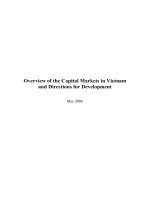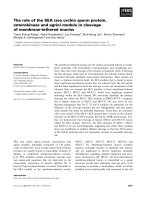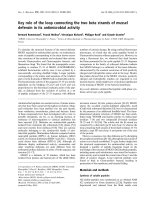Role of The Controller - Mike Allred Associate Vice Chancellor for Finance & Controller UC-Davis doc
Bạn đang xem bản rút gọn của tài liệu. Xem và tải ngay bản đầy đủ của tài liệu tại đây (318.21 KB, 15 trang )
Mike Allred
Associate Vice Chancellor
for Finance & Controller
UC-Davis
Role of
Role of
The Controller
The Controller
Who are
The UC
Controllers?
Berkeley
Berkeley
—
—
John Ellis
John Ellis
Davis
Davis
—
—
Mike Allred
Mike Allred
Irvine
Irvine
—
—
Rich Andrews
Rich Andrews
Los Angeles
Los Angeles
—
—
Sue Abeles
Sue Abeles
Merced
Merced
—
—
Steven
Steven
Dolmseth
Dolmseth
Riverside
Riverside
—
—
Bobbi McCracken
Bobbi McCracken
San Diego
San Diego
—
—
Don Larson
Don Larson
San Francisco
San Francisco
—
—
Susan Lin
Susan Lin
Santa Barbara
Santa Barbara
—
—
Jim Corkill
Jim Corkill
Santa Cruz
Santa Cruz
—
—
Kirk Lew
Kirk Lew
ANR
ANR
—
—
Jake McGuire
Jake McGuire
LBNL
LBNL
—
—
Jeffrey Fernandez
Jeffrey Fernandez
Organizational Independence
and Cooperation
Abbreviated Organization Chart
Distinct, Yet
Complementary
Controller Internal Audit
♦ Ownership of systems of
accountability and control
♦ Independent evaluation of
systems of accountability
and control
♦ Provide leadership to
management in recognizing
control responsibilities and
understanding control and
risk
♦ Provide a resource to
management in helping
assess their control
environment, and the
effectiveness and efficiency
of operations
♦ Ensure improvement
initiatives receive
management support and
provide accountability for
progress, with reporting to
stakeholders
♦ Evaluate effectiveness of
improvement initiatives, and
communicate results to
stakeholders
Roles & Responsibilities of UC
Controllers
• Established by the UC Controls Initiative
– Provide leadership and direction for implementation of the
initiative across the campus.
– Responsible for the quality of controls in areas directly
reporting to them, and will assist other campus management
in their responsibilities to ensure appropriate controls for
other campus operations
• Develop and implement campus wide system of
internal control
• Establish, evaluate and support control environment
• Provide financial leadership focus for campus
operations
UC Accounting Program
• UC maintains and operates a comprehensive
accounting program in order to:
– Meet its stewardship responsibilities
– Provide management information to all levels of the
University’s administration, as well as State and
Federal officials.
UC Accounting Program
• The University has a special stewardship
obligation to:
– Process properly and accurately all receipts and
disbursements of funds
– To account for all financial resources received and
used
– To ensure that all financial transactions conform to
legal requirements and administrative policies, and are
recorded in accordance with GAAP
– To provide reports that present a complete picture of
the University’s funds and their uses.
UC Accounting Program
• The University’s comprehensive
accounting program must provide financial
information to all levels of University
administration for:
– Use in planning and budgeting
– Evaluating the uses of funds
– Making comparative studies
UC Average Daily Expenditures
Source: 2005-06 Campus Financial Schedules (current funds only)
$ 70,945,992 Total
16,144,942 DOE Labs
1,826,227 UCOP
224,308 UCM
1,573,900 UCSC
1,580,958 UCR
2,132,615 UCSB
5,105,046 UCI
5,561,673 UCB
7,367,212 UCSD
8,114,754 UCD
9,049,185 UCSF
$ 12,265,173 UCLA
Reporting Results to Stakeholders
• Are we doing a good job?
– Annual Audit Report from UC’s External
Auditor (PwC)
• Required Communications to the Regents’
Committee on Audit
• Letter of Comments & Recommendations to the
Regents
• Letter of Comments & Recommendations to the
Chancellor
– Reports to the Board of Regents from Internal
Audit
– Audits published by agencies that sponsor UC
activities
• HHS-OIG, NSF-OIG
As Universities Get
Billions in Grants,
Some See Abuses
Cornell Doctor Blows Whistle
Over Use of Federal Funds,
Alleging Phantom Studies
Defending a Star Professor
By BERNARD WYSOCKI JR.
Staff Reporter of THE WALL
STREET JOURNAL
August 16, 2005; Page A1
House Panel Urges
Probe
Of Use of NIH Grants
By BERNARD WYSOCKI JR.
Staff Reporter of THE WALL
STREET JOURNAL
September 22, 2005; Page A4
Does anyone care about University
Accounting?
Timeline of Accounting and Investment
Regulation
• 1914 Federal Reserve created as the nation’s first bank
• 1923 GM adopts major accounting techniques used by other
big businesses
– ROI, ROE, Flexible Budgeting
• 1929 Stock Market Crash
• 1933/34 Passage of Securities Acts
– Creation of SEC
• SEC reporting requirements (10Q and 10K)
• 1936-38 The Committee on Accounting Procedure (CAP)
was created
– GAAP used for the first time
• 1953 CAP issued first GAAP codification
Timeline of Accounting and Investment
Regulation
• 1959 Accounting Principles Board (APB) was
formed to replace CAP
• 1973 The Financial Accounting Standards Board
(FASB) was formed to replace APB
• 1984 The Governmental Accounting Standards
Board was organized by the FAF
• 2002 Passage of the Sarbanes-Oxley Act
Sarbanes-Oxley Act of 2002
• Passed by Congress to help restore investor
confidence in the financial markets in the wake of
Enron, Tyco, Global Crossing, WorldCom,
HealthSouth…
– Created a new accounting oversight board to police the
practices of the accounting profession
– Strengthened auditor independence rules
– Increased the accountability of corporate officers and
directors
– Improved disclosure and financial reporting
Influence of Sarbanes-Oxley Act on UC
• PwC Report to the Regents 2002-03
– Recommendation by PwC to implement build-up
certifications to support campus representation
letter process
• Implementation
– 2003-04
• Research, Student Financial Aid, Development
(Pledges)
– 2004-05
• Fiscal-Year-End Certification Letter
– Signed by all Deans, Vice Chancellors and Vice
Provosts
– 22 Signatories at UCD for 2004-05
Influence of Sarbanes-Oxley Act on UC
FYE Certification Letter
¾ Representations made by signatory to Controller:
1. Responsible for the applications of University P&P
2. Responsible for establishing & maintaining an effective
system of internal control
3. No material transactions, accounts or agreements that
have not been properly recorded in campus accounting
records
4. Communications from regulatory agencies, donors, or
other entities concerning noncompliance…have been
disclosed in writing
5. All known allegations of fraud or suspected
fraud have been disclosed
6. Management of funds in compliance with laws,
regulations, C&G agreements, and donor
restrictions
UC Statement of Ethical Values
• We are committed to:
–
–
Integrity
Integrity
• We will conduct ourselves with integrity in our dealings with
and on behalf of the University
–
–
Excellence
Excellence
• We will conscientiously strive for excellence in our work
–
–
Accountability
Accountability
• We will be accountable as individuals and as members of
this community for our ethical conduct and for compliance
with applicable laws and University policies and directives
–
–
Respect
Respect
• We will respect the rights and dignity of others
UC Standards of Ethical Conduct
1. Fair Dealing
• …No unlawful practice or a practice at odds with
these standards can be justified on the basis of
customary practice, expediency, or achieving a
“higher” purpose.
UC Standards of Business Conduct
7. Ethical Conduct of Research
• All those engaged in research are expected to
pursue the advancement of knowledge while
meeting the highest standards of honesty, accuracy,
and objectivity. They are also expected to
demonstrate accountability for sponsors’ funds and
to comply with specific terms and conditions of
contracts and grants.
Research Noncompliance in Higher
Education
Cost of Not Doing the Right Thing
• Florida International University (2005) $13.2M
• University of Alabama (2005) 3.4M
• Mayo Foundation (2005) 6.5M
• University of Pennsylvania Children’s
National Medical Center (2005) 1.3M
• East Carolina University (2004) 2.3M
• Harvard/Beth Israel Deaconess
Medical Center (2004) 3.3M
• Johns Hopkins University (2004) 2.6M
• Northwestern University (2003) 5.5M
• Thomas Jefferson University (2000) 2.6M
• University of Pittsburg (1999) 15.5M
$56.2M
Research Noncompliance in Higher
Education
Allegations Made Against the Institutions
• Lack of accounting integrity
• Unallowable costs
• Improper use of animals
• Conflicts of Interest
• Cost Transfers – Incorrect
Accounts
• Improper Salary Expenses
• Duplicate Billings
• Inaccurate Effort Reporting
• Ineligible researchers
• Over-recovery of F&A costs
• Improper treatment of human
subjects
• False statements in reports
to Federal Government
• Failures in Integrity of
Research
• Over billing
UC Standards of Business Conduct
9. Internal Controls
• All members of the University community are
responsible for internal controls. Each business
unit or department head is specifically responsible
for ensuring that internal controls are established,
properly documented and maintained for activities
within their jurisdiction. Any individual entrusted
with funds, including principal investigators, is
responsible for ensuring that adequate internal
controls exist over the use and accountability of
such funds.
SAS 112
• Statement on Auditing Standards
– Communicating Internal Control Related
Matters Identified in an Audit has conformed
the evaluation standards of control
weaknesses of private companies and
organizations with those of public companies
subject to Sarbanes-Oxley and PCAOB audit
standards.
– Effective date for UC is July 1, 2006
SAS 112
• Under SAS 112, the standard for
determining when a control issue is either
a significant deficiency or a material
weakness has been tightened
considerably.
• Three categories of deficiencies:
– Control deficiency
– Significant deficiency
– Material weakness
SAS 112
• System-wide meeting on October, 2006
to develop implementation plan
– Each Campus, Lab & Medical Center to meet
with PwC to agree on:
• Inventory of key controls
– Document and ensure key controls are in place
• Known control issues
How will we meet these standards?
• By building strong relationships
– Improve communication
• Formal & informal
– Teamwork
– Include Deans, Dept. Chairs,
Faculty
• This is not a one person job!
How will we meet these standards?
• A Vision to Stimulate Initiatives
• Communication of Business & Infrastructure
Requirements
• Strategies to Increase Staff Productivity
• A Context for Setting Priorities
/>• Enterprisewide
Risk Work Groups
• Committee on
Accountability and
Controls
• Control Self-
Assessment
New Tools, New Methods
Six Key Components
Let’s Work Together!









